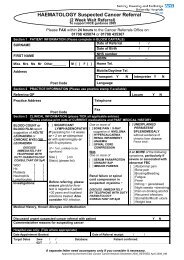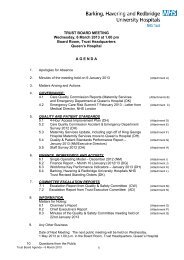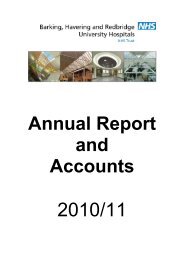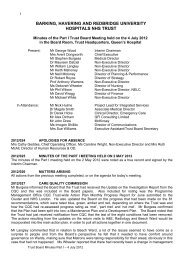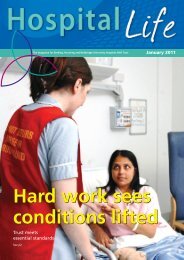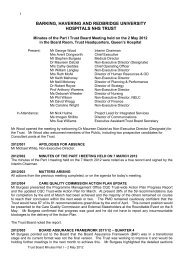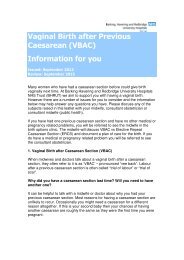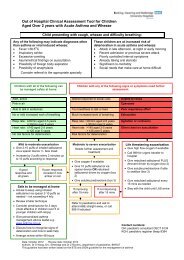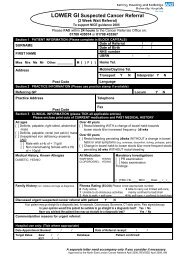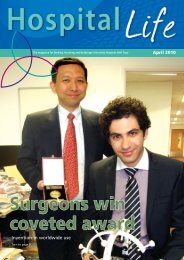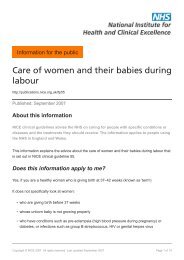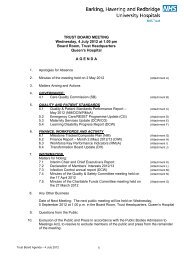BHRUT annual report 2009 - Barking Havering and Redbridge ...
BHRUT annual report 2009 - Barking Havering and Redbridge ...
BHRUT annual report 2009 - Barking Havering and Redbridge ...
You also want an ePaper? Increase the reach of your titles
YUMPU automatically turns print PDFs into web optimized ePapers that Google loves.
Annual Report & Accounts <strong>2009</strong>-2010<br />
49<br />
Loans <strong>and</strong> receivables<br />
Loans <strong>and</strong> receivables are non-derivative financial<br />
assets with fixed or determinable payments which are<br />
not quoted in an active market. After initial<br />
recognition, they are measured at amortised cost<br />
using the effective interest method, less any<br />
impairment. Interest is recognised using the effective<br />
interest method.<br />
The effective interest rate is the rate that exactly<br />
discounts estimated future cash receipts through the<br />
expected life of the financial asset, to the initial fair<br />
value of the financial asset.<br />
At the end of the <strong>report</strong>ing period, the trust assesses<br />
whether any financial assets, other than those held at<br />
‘fair value through profit <strong>and</strong> loss’ are impaired.<br />
Financial assets are impaired <strong>and</strong> impairment losses<br />
recognised if there is objective evidence of impairment<br />
as a result of one or more events which occurred after<br />
the initial recognition of the asset <strong>and</strong> which has an<br />
impact on the estimated future cash flows of the<br />
asset.<br />
For financial assets carried at amortised cost, the<br />
amount of the impairment loss is measured as the<br />
difference between the asset’s carrying amount <strong>and</strong><br />
the present value of the revised future cash flows<br />
discounted at the asset’s original effective interest rate.<br />
The loss is recognised in expenditure <strong>and</strong> the carrying<br />
amount of the asset is reduced directly/through a<br />
provision for impairment of receivables.<br />
If, in a subsequent period, the amount of the<br />
impairment loss decreases <strong>and</strong> the decrease can be<br />
related objectively to an event occurring after the<br />
impairment was recognised, the previously recognised<br />
impairment loss is reversed through expenditure to the<br />
extent that the carrying amount of the receivable at<br />
the date of the impairment is reversed does not<br />
exceed what the amortised cost would have been had<br />
the impairment not been recognised.<br />
1.25 Financial liabilities<br />
Financial liabilities are recognised on the statement of<br />
financial position when the trust becomes party to the<br />
contractual provisions of the financial instrument or, in<br />
the case of trade payables, when the goods or services<br />
have been received. Financial liabilities are derecognised<br />
when the liability has been discharged,<br />
that is, the liability has been paid or has expired.<br />
Loans from the Department of Health are recognised<br />
at historical cost. Otherwise, financial liabilities are<br />
initially recognised at fair value.<br />
Other financial liabilities<br />
After initial recognition, all other financial liabilities are<br />
measured at amortised cost using the effective interest<br />
method, except for loans from Department of Health,<br />
which are carried at historic cost. The effective<br />
interest rate is the rate that exactly discounts<br />
estimated future cash payments through the life of<br />
the asset, to the net carrying amount of the financial<br />
liability. Interest is recognised using the effective<br />
interest method.<br />
1.26 Value Added Tax<br />
Most of the activities of the trust are outside the<br />
scope of VAT <strong>and</strong>, in general, output tax does not<br />
apply <strong>and</strong> input tax on purchases is not recoverable.<br />
Irrecoverable VAT is charged to the relevant<br />
expenditure category or included in the capitalised<br />
purchase cost of fixed assets. Where output tax is<br />
charged or input VAT is recoverable, the amounts are<br />
stated net of VAT.<br />
1.27 Foreign currencies<br />
The Trust's functional currency <strong>and</strong> presentational<br />
currency is sterling. Transactions denominated in a<br />
foreign currency are translated into sterling at the<br />
exchange rate ruling on the dates of the transactions.<br />
At the end of the <strong>report</strong>ing period, monetary items<br />
denominated in foreign currencies are retranslated at<br />
the spot exchange rate on 31 March. Resulting<br />
exchange gains <strong>and</strong> losses for either of these are<br />
Annual Accounts



![[4] Biopsy Leaflet.pub - Barking, Havering and Redbridge University ...](https://img.yumpu.com/51285530/1/190x134/4-biopsy-leafletpub-barking-havering-and-redbridge-university-.jpg?quality=85)

